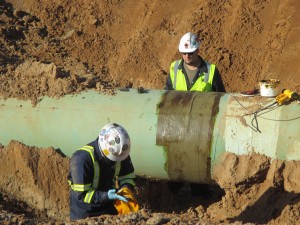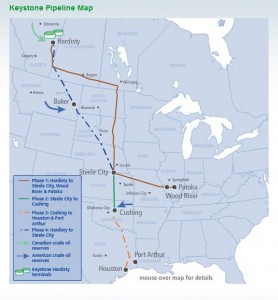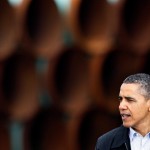Industry and Activists Battle Over Welds and Words As Crude Moves in Keystone XL

Photo Courtesy of Julia Trigg Crawford
A picture provided to StateImpact Texas from property rights activist Julia Trigg Crawford of what she said was work on the Keystone pipeline.
Before the oil started flowing in earnest through the southern part of the Keystone XL pipeline last week, land owner and property rights activist Julia Trigg Crawford noticed work crews unearthing parts of of the pipeline. When StateImpact called Crawford for a quote about the pipeline’s activation, she mentioned that activity.
“Track hoes, skids, water trucks, electrical trucks and construction crews showed up,” Crawford said. “They unearthed the pipeline, attached wires and sensors, wrapped it in something and then covered it up.”
Crawford added that TransCanada, the company that owns the pipeline, told her it had been installing temperature sensors. StateImpact Texas emailed TransCanada for confirmation, but did not hear back by the piece’s Wednesday morning deadline, a fact noted in the original article.
Wednesday evening TransCanada sent an email explaining the work.
“TransCanada is installing additional sensors and equipment on our Gulf Coast Project to further enhance our monitoring and leak detection systems,” wrote Davis Sheremata, a Media Relations staffer at TransCanada. “The installation of this equipment has been planned for some time and provides an additional layer of redundancy in our monitoring capabilities. This equipment is not required to safely operate the Gulf Coast Project and its leak detection systems.”
Shermata also gave TransCanada’s response to a report from the group Public Citizen highlighting repair work and damage to the pipeline.
“Any anomalies were identified by TransCanada and reported to PHMSA (Pipeline and Hazardous Materials Safety Administration) as opposed to the other way around,” the email asserted.
While TransCanada’s response clarified the company’s position, it also pushed back against claims that were never made in the original article.
For example, TransCanada’s email said that there had been “factual inaccuracies” and “complete inaccuracies” in the original article when it came to work done on the pipeline. In fact, the article was careful to note that TransCanda had not replied to an interview request. So, Crawford’s assertion that the company was installing “sensors” was just that, her assertion. (One that now seems to fall in-line with TransCanda’s explanation).
The original article also said Public Citizen issued a report “highlighting” work and damage on the pipeline, not that it had “discovered” that work or damage, as TransCanada’s response seemed to imply.
The company’s eagerness to push back against claims that did not appear in the original story highlights the intensity of the PR battle over the southern pipeline.
As we reported on NPR’s Morning Edition last week, that section of pipeline now plays an important role in the continued battle over the larger Keystone XL pipeline project. Environmental groups are seeking to portray the southern part of the project as troubled and dangerous, in an effort to influence opinion about the section of the pipeline that has not yet gained federal approval in the north.

TransCanada
Click here to see a larger version of a map showing the original Keystone XL pipeline route.
Meanwhile, TransCanada wants to highlight safety, as it continues to argue for the northern section of pipeline.
As Russ Girling, CEO of TransCanada, said in response to a question by StateImpact Texas at a telephone press conference last week: “Showing people that this isn’t an export pipeline, it can be operated safely, should provide the base underpinning and evidence that the Keystone XL is, at the end of the day, just another piece of energy infrastructure.”
“It is just a pipeline and it can be built and operated safely,” Girling added.
During the conference, the company also referred to the Keystone XL as the “safest pipeline” in the U.S. A notion that was, predictably, rejected by activists in an email blast following the conference.
Before the Obama administration decides on the northern section of the Keystone XL, the US State Department needs to complete an updated environmental impact study of the pipeline. TransCanada’s Girling says he expects that will be done within weeks.


